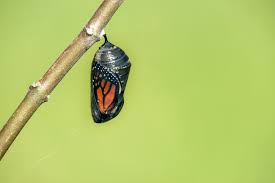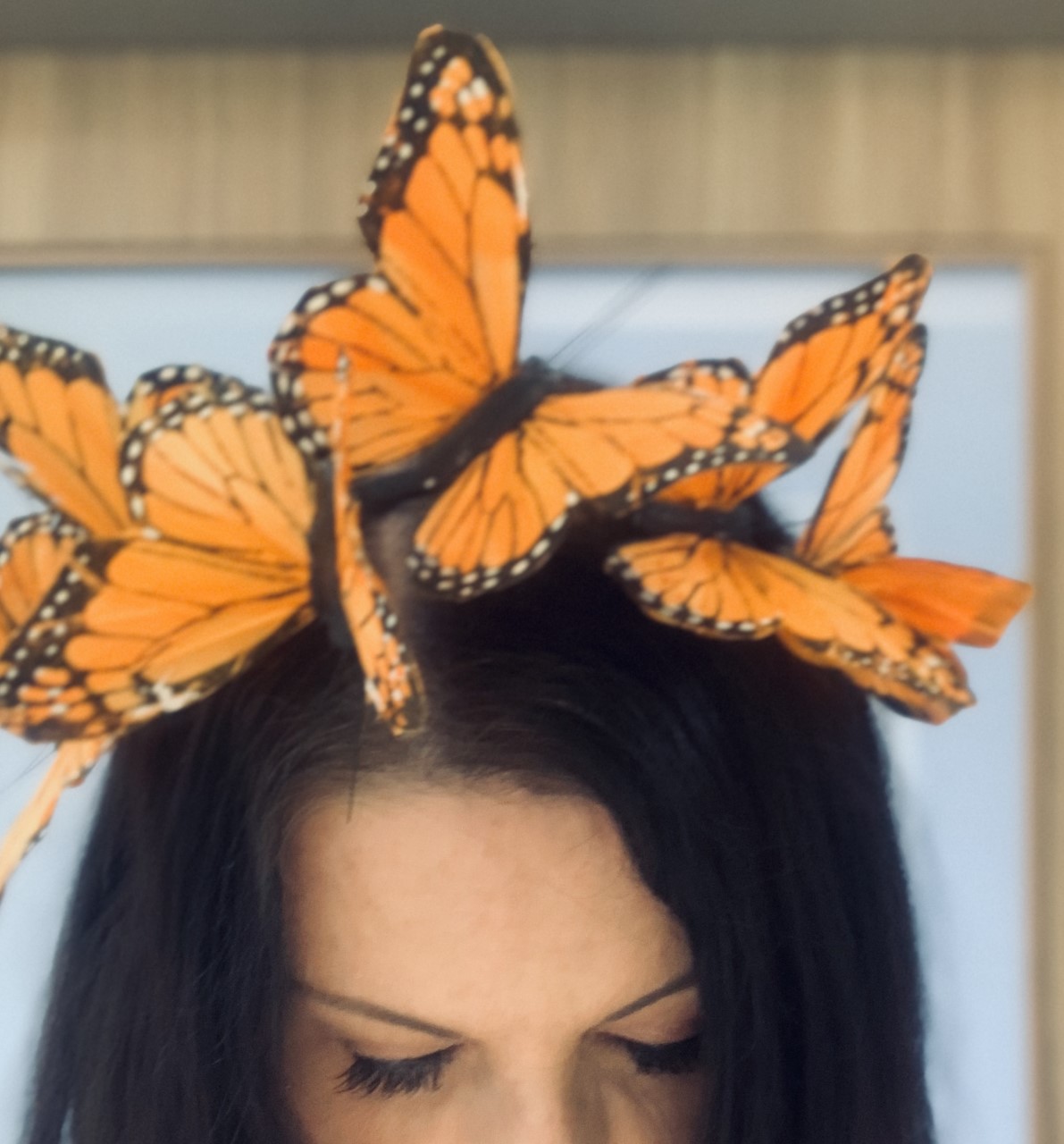I didn’t find the butterflies. They found me.
It wasn’t a complete accident. I’d heard of the importance of planting milkweed as a food source for monarchs. For this reason, it had always been my intention – I just hadn’t gotten around to it.
Gardening has been a love and a passion of mine for many years. I inherited this trait from my father. He was a man of many responsibilities. He also had a large family to support. And yet, our yard and the appearance of it’s landscaping were important to him. I have many memories of him, kneeling over fresh topsoil, using a trowel to evenly distance the things he was planting, leaving a perfect crosshatch in his wake.
I am liberal in my landscape designs. I plant things then pull them back up if I don’t like them. I plant things then dig them up to adjust their spacing. I decide plants from another area of the yard would look better here than these. I move them. I walk by the window carrying one plant, I come back carrying another. I will make numerous trips to Lowe’s on the same day, just become I am excited by a new design. Several times per year you will see me hauling and spreading huge piles of black mulch. I’m drawn to it for the contrast it brings. Over time, my tastes have matured. I have learned to use proper scale and spacing. I tend to select flowering plants of all types. I can’t think of a single year of homeownership where I haven’t changed design at least once. I don’t like change, generally speaking. I don’t do well with it in other areas of my life. When it comes to my gardening, though, change is queen. It mirrors my growing depth, my sense of humor, and the maturity I’ve gained since the last season.
I’m unable to relax outside for more than a few minutes. Something catches my eye. A weed. A plant that is off a few inches. Even having visitors or friends over doesn’t seem to stop this. I wait for a break in the conversation and say I’ll be right back. When I sit down again, I will notice something else. A banana leaf that has started to turn yellow, a flower that has fallen. It’s been a joke of my husbands for years that I have a “weeding disorder” to explain this behavior.
I’ve spent most of my life in the Midwest. Because of this, I have gained a great deal of knowledge about the plants, shrubs, and flowering trees that grow there. Spring is a season of magic. I miss it. It has always been my favorite. Seeing the first blush of spring fills me with joy. It strengthens my spirit. The purple of redbuds, the dogwood blossoms, the palest of green leaves as the trees awaken, The crocus’ and lilacs and hyacinths that push up, sometimes through the snow, bringing word that the cold darkness of winter is over. Moving to Florida three years ago removed this pleasure, but gave me a year-round growing season in return. The grass never goes dormant, the trees never drop their leaves. My hibiscus never stops blooming. It doesn’t have to be an even trade, does it? I can love both of these things.
There are few things in my life that ground me faster than the garden center at Lowe’s. I walk the aisles slowly, stopping to look at anything that catches my attention. I feel more myself while there. Calm and inspired. I fill my cart with plants, sometimes switching them around as my vision grows or becomes clearer. It was there I found tropical milkweed. I remembered my earlier intention to help the monarchs and I brought two home with me. I felt proud of myself. Look at me, everyone. I’m a tropical gardener AND an environmentalist!
I honestly thought the butterflies would stop by for some nectar and be on their way. Like one of those water stops on a marathon route, right? I knew nothing about monarchs. I could identify them, and that was about it. I was very excited to see the first one on my plants! I ran to get my phone and posted on social media that I was a success.

It took me some time to notice the caterpillars. Their distinctive black, white, and yellow banding caught my eye one day. Not too long after that, my husband pointed out a light green chrysalis on a nearby screen. I was now getting the full picture of what was going on here. The butterflies were laying eggs on my milkweed. The eggs were hatching and the caterpillars ate the milkweed until they were ready to become butterflies. As a butterfly, they would come back and lay more eggs. Their entire life cycle was being supported by milkweed. They would not eat anything else.

Less than 10% of monarchs make it that far in the wild, to butterfly. I saw the evidence of this myself. I saw many caterpillars, but only three chrysalides. Before long I moved the entire operation into the screened-in area of my pool. This benefitted the monarchs as their chances of survival increased quite a bit. This benefitted me as well, to nurture them and get to peek in on their little world every day.
I love watching them eat. They are wholly devoted. I like food – I wish I felt about any food like monarchs feel about milkweed, though. They eat it like corn on the cob. Nom nom nom nom nom – ding! Nom nom nom nom nom. They cannot get enough. They strip my plants bare. Most mornings I find only stubs of the plants I’d put in there the night before. When I unzip the habitat they all freeze. I tell them – I can still see you! Look at what you jerks did to this plant. You’re eating me out of house and home!
They know I’m just giving them a hard time, though.

A monarch’s chrysalis is inside their body the entire time. The chrysalis is their last molt. Your adorable, humorous, chubby little caterpillar with their tiny little boot- feet splits open, revealing a squirming, twisting neon -reen eyeless blob that bunches itself up then hardens. It’s pretty gross to watch, actually. I wonder if they feel fear at all, during this process. How much more vulnerable could anything be than this caterpillar is at this moment?
Seeing them emerge is worse though. Their chrysalis turns clear right before it happens. The orange and black banding of their wings is visible. The bottom cracks and long spider-like arms emerge, looking for something to hold onto. They come out head first, it’s not cute. Their head looks more like a tarantula. Their abdomen follows as gravity pulls it from the chrysalis. It looks like the body of a wasp. So far this is kind of horrifying. THEN come the wings. Finally something pretty! These are all wadded up, though. Like a used tissue. In time, as they hang, their wings fill with fluid and dry. This now resembles a butterfly instead of something from your last nightmare. They have to dry a long time before they can fly. It’s usually 4 or 5 hours before they finally let go of their chrysalis and try it.
The day my first butterfly emerged was a memorable one – for several reasons. For starters, it happened on the birthday of my youngest child. The butterfly was female, just like my baby had been. I learned something important that day. Milkweed sap is toxic and if it gets in your eyes it can cause blindness. Always wash your hands after handling milkweed. Especially before trying to put your contacts in. I didn’t know, at that time, what had gotten in my eye. I only knew it was something terrible. Unbearable stinging and burning, eye clamped shut with a steady stream of tears running down my face – I realized this was an Urgent Care situation. This being my first butterfly, though, I knew I needed to release it before we left for several hours. I reached into the habitat and got it to sit on my finger. Moving slowly, I turned and headed for the back yard. The butterfly decided to take off, though. It wasn’t very strong yet so it flew a few feet and landed right in the middle of the pool. Here’s me, pretty much blinded, one eye stinging and clamped shut screaming for help. My husband ran out, not knowing what he was going to find. Certainly not a half-blinded wife and a drowning butterfly. He was able to retrieve the butterfly – she was fine. He then took me to Urgent Care. I was also fine. I’ve also become a fastidious hand washer, coincidentally.

They truly amaze me, Monarchs. I’ve learned a lot from them. Enjoy your food, follow your instincts, be brave enough to try something new. You might think you’ve completely reached the end, but it’s only the beginning of something much better. That you couldn’t possibly be any cuter and then you become beautiful. I often wonder if they aren’t like – what’s going on here? Do they think about anything in the chrysalis? How do they know when it’s time to go do this thing? How do you suddenly know how to fly? What are they thinking, clinging to their empty chrysalis like their life depends on it? (It does.) The whole process of life is beautiful, not just our most perfected form. Molting is part of the process. Sometimes you are reduced to a squirming, eyeless blob. We are beautiful even before we emerge from the lessons of life and are finally able to fly.



I love this!! The whole process is most fascinating. I’m glad you shared it with all of us. ❤